Hong Kong Food and Drink
Visitors to Hong Kong will find authentic food from all the regions of China, including Cantonese, Northern (Peking), Chiu Chow (Swatow), Shanghai, Szechuan and Hakka. What’s more, there’s the chance to sample them in all kinds of surroundings: on a sampan in Causeway Bay or a floating restaurant at Aberdeen; in a Kowloon back-street restaurant or street market; or in the dining room of a luxury hotel. Don’t miss the chance to try one (or more) of Hong Kong’s private kitchens, which started out as unlicensed venues inside private homes but have developed into a scene of their own. Some of them are really quite upmarket and the best offer serious treats for gourmand visitors; many also have the added thrill of being in odd or unexpected locations.
Chinese dishes are by no means the whole story, though, as Hong Kong is one of the great centres for international cooking. There are stalls and restaurants serving most of the key Asian cuisines, including Indian, Vietnamese, Filipino, Singapore/Malaysian and Thai, but there’s also some truly excellent Western cooking on offer.
• Cantonese specialities include dim sum (savoury snacks, usually steamed and served in bamboo baskets on trolleys typically served until late afternoon), such as cha siu bao (barbecue pork bun), har gau (steamed shrimp dumplings) and shiu mai (steamed and minced pork with shrimp).
• The emphasis in northern food is on bread and noodles, deep frying and spicy sauces. Specialities include Peking duck (roast duck served with pancakes, spring onions and hoisin sauce or sweet bean sauce) and hotpot dishes.
• Chiu Chow cuisine is from a part of Guangdong province. It uses light, slightly vinegary sauces and is strong on seafood and roast goose.
• Hakka food is generally simple in style with baked chicken in salt among the best dishes.
• Szechuan food is hot and spicy with plenty of chillies. One speciality is barbecued meat.
Basic restaurants do not usually add service to the bill, and it is normal to leave a dollar or two as a tip. Mid-range or high-end restaurants will normally add a 10% service charge, but customers can also leave an additional tip if the service was good (leaving the coins from the change is common).
• Zhian jing (a rice wine served hot like sake).
• Liang hua pei (potent plum brandy).
• Bai jiu (a fearsome white spirit).
• Kaolian (a whisky) and Maotai.
• Popular beers are the locally brewed San Miguel and Tsingtao (from China).
Yum cha (drinking tea) is an integral part of Hong Kong's culinary culture and is the perfect compliment to most dishes. There are many tea houses in Hong Kong where tea can be drunk accompanied by bow law yau, a steaming hot bun stuffed with melted butter, or yau char gwai, a deep-fried dough. In tea houses, customers are expected to pay at the counter; a tip is not required.
Do you have any Feedback about this page?
© 2025 Columbus Travel Media Ltd. All rights reserved. No part of this site may be reproduced without our written permission, click here for information on Columbus Content Solutions.




 You know where
You know where